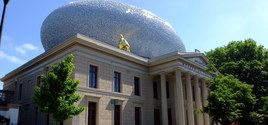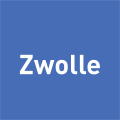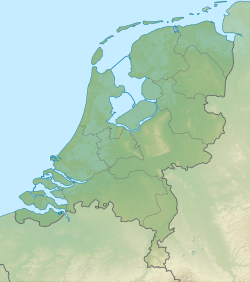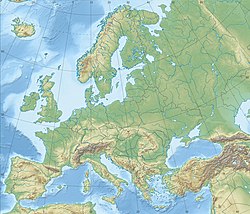Zwolle (Dutch: [ˈzʋɔlə] ⓘ) is a city and municipality in the Northeastern Netherlands. It is the capital of the province of Overijssel and the province's second-largest municipality, after Enschede, and has a population of 132,441 as of December 2023. Zwolle borders the province of Gelderland and lies on the eastern side of the River IJssel.
Zwolle | |
|---|---|
City and municipality | |
|
| |
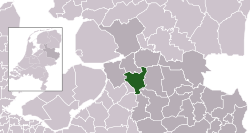 Location in Overijssel | |
| Coordinates: 52°31′N 6°6′E / 52.517°N 6.100°E | |
| Country | Netherlands |
| Province | Overijssel |
| Government | |
| • Body | Municipal council |
| • Mayor | Peter Snijders (VVD) |
| Area | |
• Municipality | 119.36 km2 (46.09 sq mi) |
| • Land | 111.10 km2 (42.90 sq mi) |
| • Water | 8.26 km2 (3.19 sq mi) |
| Elevation | 4 m (13 ft) |
| Population | |
• Municipality | 129,840 |
| • Density | 1,169/km2 (3,030/sq mi) |
| • Urban | 123,507 |
| • Metro | 181,440 |
| Demonym | Zwollenaar |
| Time zone | UTC+1 (CET) |
| • Summer (DST) | UTC+2 (CEST) |
| Postcode | 8000–8049 |
| Area code | 038 |
| Website | www |
 | |
| Click on the map for a fullscreen view | |
History
edit| Year | Pop. | ±% p.a. |
|---|---|---|
| 1404 | 3,500 | — |
| 1525 | 4,500 | +0.21% |
| 1599 | 6,500 | +0.50% |
| 1628 | 7,700 | +0.59% |
| 1670 | 10,932 | +0.84% |
| 1675 | 6,963 | −8.63% |
| 1680 | 9,388 | +6.16% |
| 1682 | 7,800 | −8.85% |
| 1748 | 11,931 | +0.65% |
| 1795 | 12,220 | +0.05% |
| Source: Lourens & Lucassen 1997, pp. 83–84 | ||
Archaeological findings indicate that the area surrounding Zwolle has been inhabited for a long time. A woodhenge that was found in the Zwolle-Zuid suburb in 1993 was dated to the Bronze Age period.[6][7] During the Roman era, the area was inhabited by Salian Franks.
The modern city was founded around 800 CE by Frisian merchants and troops of Charlemagne.[8] Previous spellings of its name include the identically pronounced Suolle, which means "hill" (cf. the English cognate verb "to swell"). This refers to an incline in the landscape between the four rivers surrounding the city, IJssel, Vecht, Aa and Zwarte Water. The hill was the only piece of land that would remain dry during the frequent floodings of the rivers. Zwolle was established on that incline.
A document mentions the existence of a parish church dedicated to St Michael. That church, the Grote of Sint Michaëlskerk (St. Michael's church), was renovated in the first half of the 15th century and exists to this day. The church contains a richly carved pulpit, the work of Adam Straes van Weilborch (about 1620), some good carving, and an exquisite Baroque organ from 1721 designed by master organ builder Arp Schnitger and completed by his sons Franz Caspar and Johann Georg.
On 31 August 1230, the bishop of Utrecht granted Zwolle city rights. Zwolle became a member of the Hanseatic league in 1294, and in 1361 joined the war between the Hanseatic League and Valdemar IV of Denmark. In the 1370 Treaty of Stralsund that ended the war, Zwolle was awarded a vitte, a trade colony, in Scania, then part of Denmark. Zwolle's golden age came in the 15th century. Between 1402 and 1450, the city's Gross Regional Product multiplied by about six.[9]
In July 1324 and October 1361, regional noblemen set fire to Zwolle. In the 1324 fire, only nine buildings escaped the flames.[10]
Zwolle was also, with Deventer, one of the centers of the Brethren of the Common Life, a monastic movement. 5 km (3 mi) from Zwolle, on a slight eminence called the Agnietenberg, (hill of St Agnes), once stood the Augustinian convent in which Thomas à Kempis spent the greatest part of his life and died (in 1471).[11]
At least as early as 1911, Zwolle had a considerable trade by river, a large fish market, and the most important cattle market in the Netherlands after Rotterdam. The more important industries comprised cotton manufactures, iron works, boat-building, dyeing and bleaching, tanning, rope-making, and salt-making.[11]
In World War II, Zwolle was single-handedly liberated from the Germans by French-Canadian soldier Léo Major.[12][13] He was made an honorary citizen of Zwolle on 14 April 2005, the 60th anniversary of his liberating of the city. He also has a street named after him, Leo Majorlaan.[14][15][16]
21st century
editIn 2004, Zwolle's De Librije restaurant was honored with 3 stars by Michelin Guide; as of 2018, it is one of only three restaurants so honored in the entire country.[citation needed]
In 2023, Tewelde Goitom, an Eritrean convicted in Ethiopia of migrant smuggling, kidnapping in Sinai and human trafficking appeared at a pretrial hearing in Zwolle, which made international headlines.[17]
Blauwvingers
editCitizens of Zwolle are colloquially known as Blauwvingers (Bluefingers). According to legend, this dates back to 1682, when the St Michael's church tower collapsed. The authorities were strapped for cash and saw no option but to sell the church bells to neighbouring city Kampen. To make sure that Kampen would not make too much profit from the deal, the local authorities asked a high price for the church bells. Kampen accepted, yet after the arrival of the bells it became clear, they were too damaged to be played. In revenge, Kampen paid in copper coins of four duiten (the equivalent of two-and-a-half cents). Zwolle distrusted Kampen and wanted to be sure they truly paid the entire price. After the rigorous counting of this vast amount of money, their fingers had turned blue from the counting of money.[18][19]
In reality, the name Blauwvinger stems from 1521, when the governors of Zwolle broke the oath of loyalty they made to the Duke of Gelre. The name Blauwvinger refers to the raised fingers, with which the governors had promised their loyalty to the Duke at his inauguration. At that time, Zwolle and Kampen were embroiled in a dispute over toll collection on the IJssel River. Zwolle initially aligned with the Duke of Gelre, Charles of Egmont, but eventually returned to the Bishop of Utrecht. During this period of political unrest, Duke Charles of Gelre was captured when he entered Zwolle. Ultimately, he was allowed to depart under the condition that Zwolle would retain its independence. The name Blauwvingers stems from the fact that the residents committed perjury twice, first to the bishop and then to the duke. [20]
Geography
editBesides the Grote of Sint Michaëlskerk (St. Michael's church), the latter which houses a majestic Baroque organ built by Arp Schnitger, there are several other historic monuments in Zwolle. The Roman Catholic Onze Lieve Vrouwe ten Hemelopneming-basilica (Our Lady of the Assumption) dates back to 1399. The church tower, called Peperbus (pepperpot), is one of the tallest and most famous church towers in the Netherlands. The modernized town hall was originally built in 1448.[11]
Mention should also be made of the Sassenpoort (one of the old city gates), the city walls, the Mosterdmakerstoren (mustard makers' tower) (the complex where local mustard used to be made), a guild-house (1571), the former provincial government offices, a Dominican monastery, and on the Melkmarkt, two museums; the Stedelijk Museum Zwolle of antiquities and natural history, and the Vrouwenhuis. Museum de Fundatie, the fine art museum of the province of Overijssel, is hosted in the former Justice Hall on Blijmarkt Square.
In the western part of the city, west of the railway station, there is a quarter of Art Nouveau buildings, concentrated mostly on Koningin Wilhelminastraat, Prinses Julianastraat, and Prins Hendrikstraat. These three-store living houses were built in 1900s by various Dutch architects. Eleven of the buildings are protected by the Dutch government (rijksmonumenten).
The Broerenkerk church was part of the Dominican monastery founded in 1465. The monastery was closed in 1580 and the monks were expelled. From 1640 until 1982 the church was used for Protestant services. After a restoration in 1983–1988 it has been used for cultural events and it is now a bookstore.[21][22]
Image gallery
edit-
Thorbeckegracht and Wijndragerstoren
-
Peperbus from the Eekwal
-
Praubstraat, inner city
-
Sassenpoort
-
Thorbeckewal and Vispoortbridge
-
The Rich Friar House a center of the Devotio Moderna and later the home of Willem Bartjens
-
View of Zwolle city centre
-
The organ in Broerenkerk
-
Herman Brood Museum & Experience
-
The Art Nouveau gate at Prins Hendrikstraat 1-3-5. 1902, architect Geurt Gijsbertus Post
-
Fountain near Museum de Fundatie
Notable residents
edit- See also People from Zwolle
- Arts, culture, entertainment and the media
- Willem Victor Bartholomeus (1825–1892), organist and conductor
- Hein Boele (born 1939), actor, Dutch voice of Elmo
- Jonnie Boer (born 1965), chef with three Michelin stars
- Gerard ter Borch (1617–1681), painter[23]
- Gerard ter Borch the Elder (1583–1662), painter
- Moses ter Borch (1645–1667), painter
- Rolf Bremmer (born 1950), scholar of Old Frisian, and of Old and Medieval English
- Tooske Breugem (born 1974), television host actress
- Herman Brood (1946–2001), painter/rock star
- Funda Eryiğit (born 1984), Turkish actress
- Willem Grasdorp (1678–1723), painter
- Aleida Greve (1670–1742), painter
- Anna Cornelia Holt (1671–1692), painter
- Sophia Holt (1658–1734), painter
- Antonina Houbraken (1686–1736), draughtswoman
- Marnix Kappers (1943–2016), actor
- Thomas à Kempis (c. 1380–1471), canon and mystic
- Master I. A. M. of Zwolle (c. 1440–1490), engraver
- Ton Koopman (born 1944), a conductor, organist, and harpsichordist
- Yuri Landman (born 1973), experimental musical instrument builder, comic book artist
- Cornelia van Marle (1661–1698), painter
- Michael Minsky (1918–1988), singer and conductor
- Leonard van Munster (born 1972), artist
- Opgezwolle (since 2001), rap crew
- Jan Vayne (Jan Veenje) (born 1966), pianist
- Charlotte Wessels (born 1987), former singer for Delain
- Aleijda Wolfsen (1648–1692), painter
- Authors
- Eef Brouwers (1939–2018), journalist and former head of the Netherlands Government Information Service
- A. den Doolaard (1901–1994), author
- Rhijnvis Feith (1753–1824), author
- Everhardus Johannes Potgieter (1808–1875), author
- Business
- Willem Jan van Dedem (1776–1851), landowner and founder of the canal and town of Dedemsvaart[24]
- Hendrikus Jacobus Gorter (1874-1918), ice skates manufacturer, cyclist and speed skater[25]
- Religion
- Johannes Busch (1399–c. 1480), church reformer and provost of the Augustinian monastic order
- Andreas Ignatius Schaepman (1815–1882), Archbishop of Utrecht
- Alanus de Rupe (1428–1475), Roman Catholic theologian and Dominican promotor of the rosary
- Politics
- Laurens Jan Brinkhorst (born 1937), former Minister of Economic Affairs
- Joan van der Capellen tot den Pol (1741–1784), role in the Batavian Republic
- Wybo Fijnje (1750–1809), Mennonite minister, publisher, exile, coup perpetrator, politician
- Willem Johan Lucas Grobbée (1822–1907), Minister of Finance from 1883 to 1885
- Johannes van Heerdt tot Eversberg (1829–1893), former governor of Suriname and Curaçao[26]
- Piet Kasteel (1901–2003), ambassador and former governor of Curaçao[27]
- Johan Rudolf Thorbecke (1798–1872), Prime Minister of the Netherlands (1849 - 1853, 1862 - 1866, 1871 - 1872)[28]
- Sports
- Anna van der Breggen, Olympic and World Champion cyclist
- Jeroen Dubbeldam (born 1973), 2000 Olympic Equestrian champion
- Marten Eikelboom (born 1973), hockey player
- Maarten Grobbe (1901–1961), football player
- Martin Haar (born 1952), former football defender and current trainer
- Rinus Israël (born 1942), former football player and current scout
- Ron Jans (born 1958), former football player and current coach
- Bert Konterman (1971), football player
- Hennie van Nee (1939–1996), football player
- Eric Pierik (born 1959), field hockey player
- Johnny Rep (born 1951), football player
- Piet Schrijvers (1946–2022), football player
- Johannes Smeekens (born 1987), Olympic speedskater
- Jaap Stam (born 1972), former football player and current coach
- Gerrit Voges (1932–2007), football player
- Peter Wessels (born 1978), tennis player
- Science
- Christianus Carolus Henricus van der Aa (1718–1793), Secretary of the Royal Holland Society of Sciences and Humanities
- Thomas Joannes Stieltjes (1856–1894), mathematician, civil engineer and politician
- Derk-Jan Dijk (Born 1958), Researcher of sleep and circadian rhythms
Educational institutions
editZwolle is home to several universities and colleges:
Transport
editRoad transport
editZwolle is a hub in the national highway network, and gateway to northern Netherlands. This is reflected in the high traffic volumes in and around the city. The A28 serves Zwolle with 4 exits, and runs from Utrecht to Groningen. It is being widened to 8 lanes across the IJssel River and 6 lanes from Zwolle to Meppel in 2010 and 2011. The motorway initially opened between 1964 and 1970.[29] Another motorway, the A50, interchanges with A28 just west of the city, offering a route for southbound traffic to Apeldoorn and Eindhoven.
The N35 highway starts in Zwolle, where it forms the eastern section of the ring road of Zwolle, it runs as a non-motorway to Almelo and continues to Enschede as A35 motorway. The ringroad is mainly a 4-lane road, with numerous traffic lights. It forms a full ring, and also exists out of the N337 highway that runs to Deventer. Other sections of the ring road are not numbered. Parts of the ring road were widened to six lanes in 2010. Other numbered highways running from Zwolle are N331 to Hasselt, N758 to Nieuwleusen, N340 to Ommen and N764 to Kampen.
Bridges
editDue to nearby rivers, there are several major bridges in and around Zwolle. The most important bridge is the IJssel Bridge where the A28 motorway runs across. It was completed in 1970 and carries over 125.000 vehicles per day. Adjacent to this bridge is the older IJssel Bridge, which opened in 1930 and was destroyed twice during World War II. A third IJssel Bridge is the railway bridge (called Hanze boog) which carries the railway line from Zwolle to Amersfoort, and from 2012, to Lelystad. There are several bridges across the Zwarte Water River, including two 4-lane bridges, a 2-lane bridge, and a bus/bicycle bridge. There is also a bridge across the Vecht, which carries A28 motorway. Another local bridge is adjacent to this bridge. A third bridge carries rail traffic to Leeuwarden and Groningen. Numerous local bridges exist around the historic city center.
Rail transport
editThe first train in Zwolle arrived on 6 June 1864. Today the city has rail connections in eight directions (viz. Kampen, Leeuwarden, Groningen, Emmen, Enschede, Arnhem/Nijmegen, Lelystad/Amsterdam, and Amersfoort).
The rail connection with Amsterdam via Lelystad – the Hanzelijn – is operational since December 2012.
The second station, Zwolle Stadshagen, was opened on 15 December 2019.
Water transport
editZwolle is located on or near three rivers (Zwarte Water, Vecht, and IJssel), several canals (the now disused Willemsvaart, Nieuwe Vecht and Overijssels Kanaal and the modern Zwolle-IJssel Kanaal). There are some water-related industries in Zwolle, mainly in the Voorst industrial area.
International relations
editTwin towns—sister cities
editZwolle is currently twinned with:
- Lünen, Germany
In the past, Zwolle had partnerships with:[citation needed]
- Érsekhalma, Hungary
- Rutobwe, Rwanda
- Vologda, Russia
- Kaliningrad, Russia
There is also a small rural town in the U.S. State of Louisiana named after Zwolle. The two cities maintain close informal ties.[30]
References
edit- ^ "Portefeuille burgemeester Peter Snijders" [Tasks of mayor Peter Snijders] (in Dutch). Gemeente Zwolle. Archived from the original on 6 October 2019. Retrieved 6 October 2019.
- ^ "Kerncijfers wijken en buurten 2020" [Key figures for neighbourhoods 2020]. StatLine (in Dutch). CBS. 24 July 2020. Retrieved 19 September 2020.
- ^ "Postcodetool for 8011PK". Actueel Hoogtebestand Nederland (in Dutch). Het Waterschapshuis. Archived from the original on 7 January 2019. Retrieved 25 March 2014.
- ^ "Bevolkingsontwikkeling; regio per maand" [Population growth; regions per month]. CBS Statline (in Dutch). CBS. 1 January 2021. Retrieved 2 January 2022.
- ^ "Bevolkingsontwikkeling; Regionale kerncijfers Nederland" [Regional core figures Netherlands]. CBS Statline (in Dutch). CBS. 1 January 2020. Retrieved 8 March 2021.
- ^ Theo Holleman (1996), Een verleden op de schop, University Press, Amsterdam, ISBN 90-5356-189-7
- ^ Hove, ten J. (2005). Geschiedenis van Zwolle Zwolle: Waanders. ISBN 90-400-9050-5
- ^ F.C. Berkenvelder (1980). "Het begin". Zwolle 750 jaar stad (in Dutch). Waanders. Archived from the original on 16 August 2006. Retrieved 17 March 2007.
- ^ F.C. Berkenvelder (1980). "De handel en de Hanze". Zwolle 750 jaar stad (in Dutch). Waanders. Archived from the original on 23 May 2012. Retrieved 17 March 2007.
De stedelijke geldmiddelen, het nationaal inkomen zouden wij nu zeggen, die in 1402 nog 6.000 gulden bedroegen waren in 1450 bijna verzesvoudigd tot 34.000 gulden. (Translated: The city's financial resources, the national income as we would now call it, which were 6,000 guilders in 1402, had by 1450 multiplied by six to 34,000 guilders.)
- ^ "Zwolle op keerpunt van bestaan" (in Dutch). De Stentor. 2 March 2005.
- ^ a b c One or more of the preceding sentences incorporates text from a publication now in the public domain: Chisholm, Hugh, ed. (1911). "Zwolle". Encyclopædia Britannica. Vol. 28 (11th ed.). Cambridge University Press. p. 1064.
- ^ "Léo Major | Canadian soldier".
- ^ "The One-Eyed Scout Who Liberated a Whole Town By Himself by Simple History". YouTube. Archived from the original on 13 November 2021.
- ^ "Canada Remembers Times Veterans' Week Special Edition". Veterans Affairs Canada. 24 August 2020. Retrieved 24 August 2021.
- ^ Goyjer, Jim (2 October 2020). "Visit Zwolle: Home of the Bluefingers and a French-Canadian Hero". Dutch Review. Archived from the original on 24 August 2021. Retrieved 24 August 2021.
- ^ Moncure, Billy (11 March 2019). "A Mad Major: The Canadian Hero Who Captured A City". War History Online. Retrieved 24 August 2021.
- ^ "Alleged Eritrean People Smuggler Appears in Dutch Court". 10 January 2023.
- ^ Boxma, Willem (2001). "Steuren, blauwvingers, kwekweschudders en tukkers. Schimpnamen in Overijssel". Traditie. Tijdschrift over Tradities en Trends. (in Dutch). 2: 26–27. ISSN 1382-4104.
- ^ "In welke stad wonen de blauwvingers?" (in Dutch). Nederlands Centrum voor Volkscultuur. Archived from the original on 11 January 2006. Retrieved 21 March 2007.
- ^ "De Blauwvingers van Zwolle". Historiek (in Dutch). 8 November 2021. Retrieved 28 October 2023.
- ^ "Zwolle (Ov): Broerenkerk". archimon.nl. Retrieved 10 August 2013.
- ^ Scholten, Rick. "Waanders in the Broerenkerk". Retrieved 10 August 2013.[permanent dead link]
- ^ . Encyclopædia Britannica. Vol. 26 (11th ed.). 1911.
- ^ "Willem Jan baron van Dedem (1776-1851)". Wie is wie in Overijssel (in Dutch). Retrieved 14 March 2022.
- ^ Waarom kent u deze beroemde Zwollenaar niet?. Marco van den Berg, De Stentor, 4 January 2019.
- ^ "J.H.A.W. baron van Heerdt tot Eversberg". Dutch Parliament (in Dutch). Retrieved 11 February 2022.
- ^ Jan Kuijk en Pieter van der Ven (17 December 2003). "Leven met Kuyper, Gerbrandy en zoon Karel". Trouw (in Dutch). Retrieved 12 February 2022.
- ^ . Encyclopædia Britannica. Vol. 26 (11th ed.). 1911.
- ^ "completion dates A28 at autosnelwegen.nl".
- ^ "Going Dutch - in Zwolle, Louisiana". Natasha Sanchez. 14 June 2014. Retrieved 8 January 2024.
Literature
edit- Lourens, Piet; Lucassen, Jan (1997). Inwonertallen van Nederlandse steden ca. 1300–1800. Amsterdam: NEHA. ISBN 9057420082.
External links
edit- Media related to Zwolle at Wikimedia Commons
- Zwolle travel guide from Wikivoyage
- Official website


